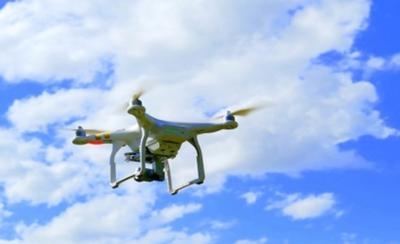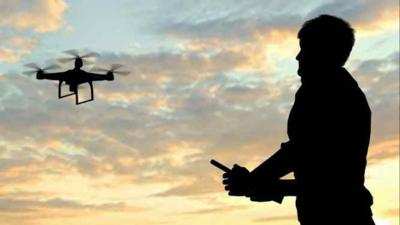Bill's Authors Say Goal Is To Protect Air Traffic From Collisions With Unmanned Aircraft
U.S. Representative Jim Langevin (D-RI) and Senator Sheldon Whitehouse (D-RI) have introduced the Drone Operator Safety Act in the U.S. House of representatives, a bill to they say is intended to help protect American air traffic from the "misuse" of drones.

According to a news release on Congressman Langevin's website, the bill would make it a criminal offense to fly a drone in a way that poses a safety risk to the operation of a manned aircraft. It would also prohibit operators from flying drones near an airport’s runways without permission from the airport’s air traffic control tower. Violators would be subject to a fine and/or prison time.
“While drones provide exciting opportunities for hobbyists and have great commercial potential, they can pose serious risks to other aircraft,” said Langevin. “This bill makes it clear that drone operators must be responsible for the safe operation of their vehicles to ensure the protection of air travelers in America.”
“Drone operators who interfere with commercial air space put Americans’ safety at risk and give drones a bad name. This bill would crack down on that dangerous behavior and hold bad actors accountable,” said Whitehouse who has worked previously on air-safety legislation in the Senate. “I’m happy to join Jim Langevin to introduce this bill and help make sure drones are used responsibly.”
According to Earl Lawrence, Director of the FAA’s Unmanned Aircraft Systems Integration Office, pilots are reporting an increasing number of drone sightings, with 1,800 such reports in 2016, up from 1,200 the year before. While the FAA has the authority to levy civil penalties on individuals operating drones in a manner that puts people and property at risk, there currently is no criminal provision that directly addresses the unsafe operation of drones.
The legislation was included in the Senate Federal Aviation Administration reauthorization, which passed the Senate last year.
Drone attorney Jonathan Rupprecht posted an overview of the bill on his blog. According to Rupprecht, the bill creates a runway exclusion zone that extends 1 mile off the end of a runway. "The only way you can fly in the runway exclusion zone is if you have authorization.Flying in this runway exclusion zone is a federal misdemeanor punishable up to a year in federal prison and/or a $100,000 fine; however, if the misdemeanor results in death, they could be fined $250,000. See 18 U.S.C. § 3559 and 18 U.S.C. § 3571," Rupprecht writes.
In addition to the runway exclusion zone, it creates a crime that can happen ANYWHERE. "The penalty for flying “knowingly or recklessly interfering with, or disrupting the operation of, an aircraft or other airborne vehicle carrying 1 or more occupants operating in the special aircraft jurisdiction of the United States, in a manner that poses an imminent safety hazard to such occupants.” A violation of this is punishable up to a year in federal prison and/or a $100,000 fine unless death happens which then makes the fine up to $250,000," Rupprecht writes.
It also forbids attempted or caused great bodily harm or death and allows for punishment up to life in prison. This kind of makes sense. A prosecutor needs to have a wide range of punishments to work with when prosecuting. The federal crime of attempted murder with a gun is a maximum of 20 years; "however, if you are trying to take out an airliner, that is like 130+ attempts of murder," he said.
The bill is not all bad, Rupprecht said. Among the positives are:
- It will deter people from flying drones next to airports or aircraft. This is good because I’m tired of the drone “near misses” that are reported on the news which are later used for justification for some state or local laws.
- It will force commercial drone operators to use the FAA authorization process to obtain a FAA authorization which basically will act like the get out of jail free card.

However, there is a lot to be concerned about in the bill. "I’ve seen this before where overzealous law enforcement will arrest a person claiming the drone was being operated in the sky near an aircraft (whatever “near” means) which in the officer’s opinion would have killed everyone if there was a collision. This is exactly what happened in the Turgeon case in North Dakota. A law enforcement officer arrested him and he was charged with 2 counts of reckless endangerment and 1 felony level reckless endangerment (because the officer thought he could have taken out the airplane flying overhead). Turgeon later was found not guilty.
"The Turgeon case was NOT an outlier," he continued in the post. "Wilkins Mendoza and Remy Castro were both charged under New York’s felony careless and reckless laws, but prosecutors dropped their case. See also my article on the 23 enforcement actions the FAA did where 19 of them were prosecuted under state law also. These laws are easy to arrest under but hard to prosecute."
Rupprecht is also concerned about the broad nature of the bill. "It applies to “airports” which means you can get in trouble flying in the runway exclusion zone of a … class G airport that rarely sees any traffic. 'Airports' needs to be defined better to be narrow," he said.
"It is written so broadly that I can see helicopter pilots, crop dusters, etc. all getting more aggressive with drone operators. I think it would be wise to create some type of language that this interference charge cannot happen below a certain altitude (200 or 400 ft AGL) or within a certain distance of a structure. Hobbyists do not have any altitude restrictions like the 107 operators do (400 ft AGL).This way loitering airplanes and helicopters cannot be used to suppress drones being used underneath them. Think about it, if you want to hide something, you just fly manned aircraft up in the sky and arrest whoever flies their drone. Any journalists see a problem here?
"I don’t believe all the airport phone lines are recorded (that is what a FAA FOIA processor told me) so there are potential situations where hobbyists could get permission but have no proof of authorization to fly in the exclusion zone.
There are no air traffic control towers for many of the airports out there so this creates a problem. Furthermore, the FAA is not giving out authorizations under Part 107 to class G airports."
(Sources as cited. Images from file)
 ANN's Daily Aero-Term (04.26.24): DETRESFA (Distress Phrase)
ANN's Daily Aero-Term (04.26.24): DETRESFA (Distress Phrase) ANN's Daily Aero-Linx (04.26.24)
ANN's Daily Aero-Linx (04.26.24) Airborne 04.22.24: Rotor X Worsens, Airport Fees 4 FNB?, USMC Drone Pilot
Airborne 04.22.24: Rotor X Worsens, Airport Fees 4 FNB?, USMC Drone Pilot Airborne 04.24.24: INTEGRAL E, Elixir USA, M700 RVSM
Airborne 04.24.24: INTEGRAL E, Elixir USA, M700 RVSM Airborne-NextGen 04.23.24: UAVOS UVH 170, magni650 Engine, World eVTOL Directory
Airborne-NextGen 04.23.24: UAVOS UVH 170, magni650 Engine, World eVTOL Directory




